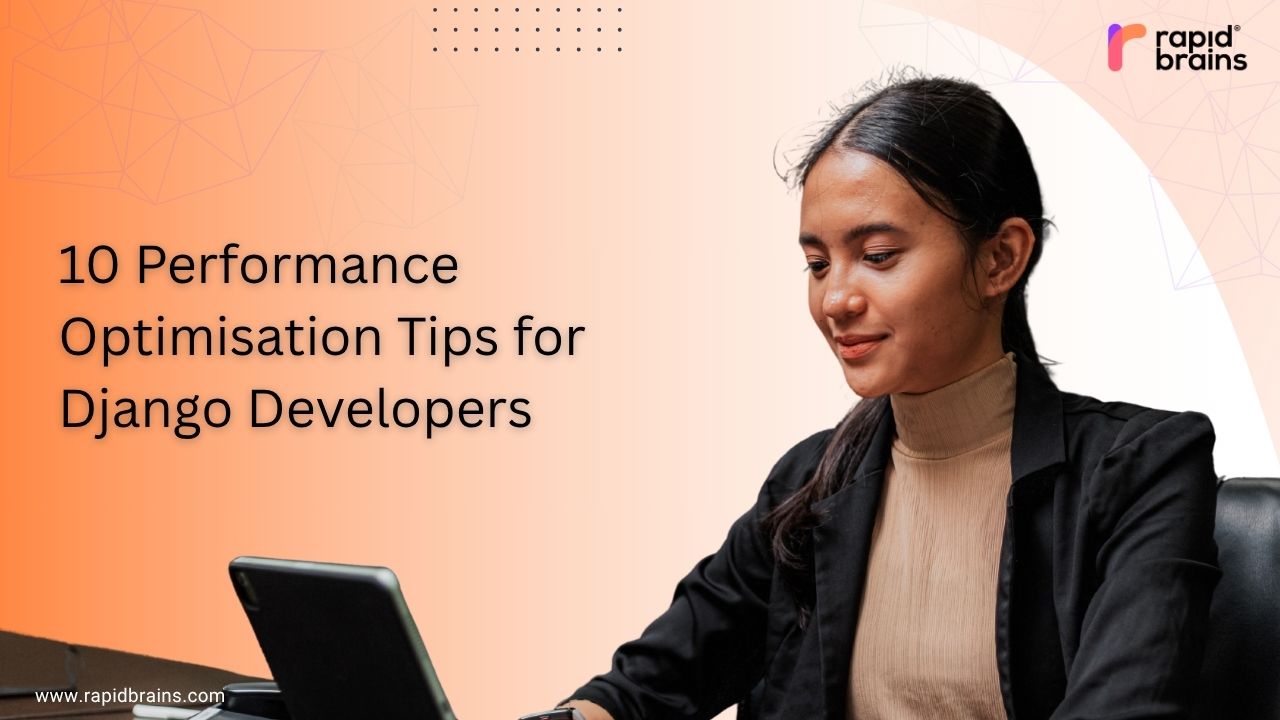
A robust, high-level Python web framework, Django promotes rapid development and clean, pragmatic design. However, as your application grows, performance bottlenecks can creep in. These ten proven tips will help you build scalable, high-performing Django applications, whether you’re honing your skills or looking into the advantages of Django developers for your project.
1. Use Select Related and Prefetch Related for Query Optimisation
One of the most common performance issues in Django is the N+1 query problem. Use select_related() for one-to-one and foreign key relationships, and prefetch_related() for many-to-many or reverse foreign key relationships. These functions drastically reduce unnecessary database hits and speed up data retrieval. Knowing this is one of the advantages of Django developers who understand the ORM well and apply smart Django performance optimisation practices.
2. Enable Database Indexing
Indexes significantly speed up database lookups. In Django, use the Meta class inside your models to define indexes. Focus especially on fields used frequently in filters or sorting. This not only enhances performance but also highlights one of the advantages of Django, its ability to streamline complex data interactions effortlessly.
3. Leverage Django’s Caching Framework
Caching reduces server load and improves response times. Django supports in-memory caching (like Memcached or Redis), file-based, and database-based solutions. An effective caching strategy is essential for Django performance optimisation and is often what separates a regular developer from the best Django developer.
4. Optimise Template Rendering
Avoid placing complex logic inside templates. Preprocess data in views and consider enabling template-level caching for high-traffic pages. This subtle improvement can drastically enhance performance, showing how the advantages of Django developers extend beyond just writing code they think about maintainability and speed too.
5. Minimise Middleware and Use Only What’s Necessary
Each middleware layer introduces overhead in the request/response cycle. Review your middleware stack regularly and remove anything unnecessary. A clean and purposeful middleware setup supports better Django performance optimisation and is a sign of the best Django developer at work.
6. Use Asynchronous Views Where Appropriate
As of Django 3.1, asynchronous views and middleware are supported. Use async for I/O-bound tasks like calling APIs or handling WebSockets. This modern capability demonstrates the advantages of Django and adds scalability to your tech stack.
7. Use Connection Pooling
Creating new DB connections per request is resource-intensive. Use tools like pgbouncer for PostgreSQL or leverage SQLAlchemy’s connection pooling strategies. When you hire dedicated Django developers, ensure they know these techniques—they’re common skills of the best Django developers.
8. Optimise Static Files Handling
In development, Django serves static files inefficiently. Use Whitenoise or production-grade web servers like Nginx to serve static and media files. Compress and version your assets to reduce load time. Effective file management illustrates the advantages of Django developers with a full-stack perspective.
9. Monitor with Profiling Tools
Profiling tools like Django Debug Toolbar, Silk, or New Relic offer deep insights into queries, template rendering, and cache usage. Regular monitoring is key to sustainable Django performance optimisation and essential for the best Django developer looking to fine-tune every part of an application.
10. Use Content Delivery Networks (CDNs)
A CDN reduces latency by serving static content closer to the user. Integrating a CDN with your Django project lightens the server load and boosts speed—a smart move by developers or businesses who choose to hire dedicated Django developers focused on user experience.
Flask vs Django vs Ruby on Rails
While Django is a full-stack Python framework with built-in features like admin panels, ORM, and authentication, Flask is a lightweight microframework that offers more flexibility and simplicity. Flask suits smaller applications and developers who prefer to build custom architecture from the ground up.
Ruby on Rails is a powerful, opinionated framework known for convention over configuration and rapid prototyping. It’s similar to Django in terms of scalability and is often chosen for startups that need to move fast.
If you want to learn more about the Flask framework advantages, explore this blog: Flask vs Django
Django is ideal for larger projects that require robustness, scalability, and security, while Flask offers more control, and Ruby on Rails provides a highly productive development experience.
Why Django Performance Matters
Why You Should Optimise Django Applications. One of the standout advantages of Django is how easily it scales when optimised properly. Performance tuning in Django leads to:
- Improved User Experience
- Lower Hosting and Infrastructure Costs
- Better SEO Rankings
- Faster Scaling During High Traffic
When you understand these benefits, you’ll also recognise the advantages of Django developers who proactively apply these principles. If you’re looking to hire dedicated Django developers, be sure they have practical experience with Django performance optimisation techniques.
Conclusion
Performance tuning in Django doesn’t have to be intimidating. By implementing the tips above, your application can remain fast, scalable, and cost-efficient.
These best practices highlight the advantages of Django as a framework and reinforce the value of working with experts. Suppose you’re aiming to hire dedicated Django developers who specialise in performance, or you want to become the best Django developer yourself. In that case, platforms like RapidBrains connect you with pre-vetted remote talent ready to deliver.
Whether you’re starting or scaling up, focusing on Django performance optimisation will ensure long-term success, one of the defining traits of the best Django developers committed to excellence.




